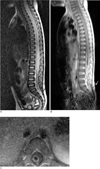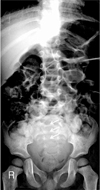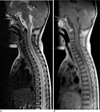Abstract
Dermal sinus tracts are remnants of incomplete neural tube closure. Dermal sinus tracts in the spine range from asymptomatic pits to tracts with significant disease. Congenital spinal dermal sinus tract can produce significant morbidity if not adequately managed. Spinal subdural abscess caused by the spread of an infection within the dermal sinus tract is rare in children. We now described a 3-year-old male who presented with extensive spinal subdural abscess resulting from dermal sinus tract that was low-lying in the sacral area.
Figures and Tables
Fig. 2
Dermal sinus tract complicated with spinal subdural abscess in a 3-year-old boy.
A. Sagittal T2WI shows high signal intense lesion in the subdural space occupying lesion from T7 to L3.
B. Gadolinium enhanced sagittal T1WI shows rim-like enhancement in the subdural lesion, and transverse line with low signal intensity (white arrow), suggesting dermal sinus.
C. Gadolinium enhanced axial T1WI shows the lesion more clearly as being subdural and intramedullary.

References
1. Velissaris D, Aretha D, Fligou F, Filos KS. Spinal subdural staphylococcus aureus abscess : case report and review of the literature. World J Emerg Surg. 2009; 4:31.
2. Benzil DL, Epstein M, Knuckey N. Intramedullary epidermoid associated with an intramedullary spinal abscess secondary to a dermal sinus. Neurosurgery. 1992; 30:118–120.
3. Chen CY, Lin K, Wang H, Lui T. Dermoid cyst with dermal sinus tract complicated with spinal subdural abscess. Pediatr Neurol. 1999; 20:157–160.
4. Jang JW, Kim SY, Kim HS, Lee EJ, Lee SG. A Case of Recurrent Bacterial Meningitis Associated with Lumbosacral Dermal Sinus during Early Infancy. J Korean Child Neurol Soc. 2006; 14:153–157.
5. Park SW, Yoon SH, Cho KH, Shin YS, Ahn YH. Infantile lumbosacral spinal subdural abscess with sacral dermal sinus tract. Spine (Phila Pa 1976). 2007; 32:E52–E55.
6. Dev R, Husain M, Gupta A, Gupta R. MR of multiple intraspinal abscess associated with congenital dermal sinus. AJNR Am J Neuroradiol. 1997; 18:742–743.
7. Guzel N, Eras M, Guzel D. A child with spinal intramedullary abscess. Childs Nerv Syst. 2003; 19:773–776.




 PDF
PDF ePub
ePub Citation
Citation Print
Print




 XML Download
XML Download